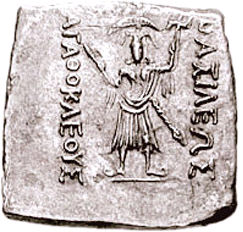சங்கர்ஷணர்
| சங்கர்ஷணர் | |
|---|---|
 | |
| வகை | பலராமன், விஷ்ணு[5] |
| பெற்றோர்கள் | ரோகிணி தேவி (தாய்) வசுதேவர் (தந்தை) |
| சகோதரன்/சகோதரி | கிருஷ்ணர் (இளைய சகோதரர்) சுபத்திரை (சகோதரி) |
| வைணவம் தொடரின் ஒரு பகுதி |
|---|
 |
சங்கர்ஷணர் (Saṃkarṣaṇa) கலப்பையை ஆயுதமாகக் கொண்டவர் எனப்பொருள்[6] வசுதேவருக்கும் முதல் மனைவி ரோகிணி தேவிக்கும் பிறந்தவர் பலராமன் மற்றும் சுபத்திரை ஆவர். வசுதேவருக்கும்-இரண்டாம் மனைவி தேவகிக்கும் பிறந்தவர் கிருஷ்ணர் ஆவர். பலராமன் எனும் சங்கர்ஷணர் யாதவர்களில் ஒரு பிரிவினரான விருஷ்ணி குலத் தலைவராக அறியப்பட்டார்.[7][8][9] [10]விஷ்ணுவின் அவதாரமாக சங்கர்ஷணர் அறியப்பட்டார். பிற்காலத்தில் வைணக் கோயில்களில் சங்கர்ஷணர் வழிபாடு நிலவியது.[11][12][13][14]
பரவாசுதேவர், சங்கர்ஷணர், அனிருத்தன், பிரத்திம்யும்மனன் என்ற பெயர்களில், நாராயணனாகிய பரம்பொருள் தன்னையே இந்நால்வராக்கிக்கொண்டு படைப்பு முதலிய தொழில்களில் ஈடுபடுகிறார்; பரவாசுதேவர் மற்ற மூவருடைய பணிகளுக்கு தலைவராக இருக்கிறார். ஆகமத்தை ஒட்டி நடக்கும் வைணவ ஆலய வழிபாட்டில் இந்த வியூக நிலைக்கும் பெயர்களுக்கும் அதிக இடம் உள்ளது. வைணவக் கோயில்களில் சங்கர்ஷணருக்கு தனிச்சன்னதிகள் உண்டு.
ஹேலியோடோரஸ் தூண் அருகே அமைந்த பெஸ்நகரத்தில் விருஷ்ணி குல நாயகர்களான கிருஷ்ணன், பலராமன் என்ற சங்கர்ஷணர், அனிருத்தன், பிரத்தியும்மனன் ஆகியோரின் வழிபாடு குறித்தான சிற்பங்கள் கண்டெடுக்கப்பட்டது.[18]
இராஜஸ்தான் மாநிலத்தின் ஆத்திபாத பிராமி கல்வெட்டில் கிமு முதல் நூற்றாண்டில் நாராயணனுடன் வாசுதேவர் மற்றும் சங்கர்ஷணர் வழிபாடு குறித்துள்ளது.

மேற்கோள்கள்
[தொகு]- ↑ Singh, Upinder (2008). A History of Ancient and Early Medieval India: From the Stone Age to the 12th Century (in ஆங்கிலம்). Pearson Education India. pp. 436–438. பன்னாட்டுத் தரப்புத்தக எண் 978-81-317-1120-0.
- ↑ Osmund Bopearachchi, Emergence of Viṣṇu and Śiva Images in India: Numismatic and Sculptural Evidence, 2016.
- ↑ 3.0 3.1 Srinivasan, Doris (1997). Many Heads, Arms, and Eyes: Origin, Meaning, and Form of Multiplicity in Indian Art (in ஆங்கிலம்). BRILL. p. 215. பன்னாட்டுத் தரப்புத்தக எண் 978-90-04-10758-8.
- ↑ Austin, Christopher R. (2019). Pradyumna: Lover, Magician, and Scion of the Avatara (in ஆங்கிலம்). Oxford University Press. p. 22. பன்னாட்டுத் தரப்புத்தக எண் 978-0-19-005412-0.
- ↑ Bryant, Edwin F., ed. (2007). Krishna: A Sourcebook. New York: Oxford University Press. p. 114. பன்னாட்டுத் தரப்புத்தக எண் 978-0-19-514891-6.
- ↑ "Sanskritdictionary.com: Definition of saṃkarṣaṇa". www.sanskritdictionary.com.
- ↑ Vāsudeva and Krishna "may well have been kings of this dynasty as well" in Rosenfield, John M. (1967). The Dynastic Arts of the Kushans (in ஆங்கிலம்). University of California Press. pp. 151–152 and Fig.51.
- ↑ Williams, Joanna Gottfried (1981). Kalādarśana: American Studies in the Art of India (in ஆங்கிலம்). BRILL. p. 129. பன்னாட்டுத் தரப்புத்தக எண் 978-90-04-06498-0.
- ↑ Paul, Pran Gopal; Paul, Debjani (1989). "Brahmanical Imagery in the Kuṣāṇa Art of Mathurā: Tradition and Innovations". East and West 39 (1/4): 132–136, for the photograph p. 138. பன்னாட்டுத் தர தொடர் எண்:0012-8376.
- ↑ Smagur, Emilia (in en). Vaishnavite Influences in the Kushan Coinage, Notae Numismaticae- Zapiski Numizmatyczne, X (2015). p. 67. https://www.academia.edu/24021513.
- ↑ Curta, Florin; Holt, Andrew (2016). Great Events in Religion: An Encyclopedia of Pivotal Events in Religious History [3 volumes] (in ஆங்கிலம்). ABC-CLIO. p. 271. பன்னாட்டுத் தரப்புத்தக எண் 978-1-61069-566-4.
- ↑ Doris Srinivasan (1997). Many Heads, Arms, and Eyes: Origin, Meaning, and Form of Multiplicity in Indian Art. BRILL Academic. pp. 211–220, 236. பன்னாட்டுத் தரப்புத்தக எண் 90-04-10758-4.
- ↑ Gavin D. Flood (1996). An Introduction to Hinduism. Cambridge University Press. pp. 119–120. பன்னாட்டுத் தரப்புத்தக எண் 978-0-521-43878-0.
- ↑ Christopher Austin (2018). Diana Dimitrova and Tatiana Oranskaia (ed.). Divinizing in South Asian Traditions. Taylor & Francis. pp. 30–35. பன்னாட்டுத் தரப்புத்தக எண் 978-1-351-12360-0.
- ↑ Gupta, Vinay K.. "Vrishnis in Ancient Literature and Art" (in en). Indology's Pulse Arts in Context, Doris Meth Srinivasan Festschrift Volume, Eds. Corinna Wessels Mevissen and Gerd Mevissen with Assistance of Vinay Kumar Gupta: 81. https://www.academia.edu/40656540.
- ↑ Austin, Christopher R. (2019). Pradyumna: Lover, Magician, and Scion of the Avatara (in ஆங்கிலம்). Oxford University Press. p. 24. பன்னாட்டுத் தரப்புத்தக எண் 978-0-19-005412-0.
- ↑ Shaw, Julia (2016). Buddhist Landscapes in Central India: Sanchi Hill and Archaeologies of Religious and Social Change, c. Third Century BC to Fifth Century AD (in ஆங்கிலம்). Routledge. p. 74. பன்னாட்டுத் தரப்புத்தக எண் 978-1-315-43263-2.
- ↑ Indian History (in ஆங்கிலம்). Allied Publishers. 1988. p. A-222. பன்னாட்டுத் தரப்புத்தக எண் 978-81-8424-568-4.
மேலும் காண்க
[தொகு]- Charles Allen (2017), "6", Coromandel: A Personal History of South India, Little Brown, பன்னாட்டுத் தரப்புத்தக எண் 978-1408705391
- Mirashi, Vasudev Vishnu (1981), History and Inscriptions of the Satavahanas: The Western Kshatrapas, Maharashtra State Board for Literature and Culture
- Fortson, Benjamin W., IV (2004). Indo-European Language and Culture. Blackwell Publishing. பன்னாட்டுத் தரப்புத்தக எண் 1-4051-0316-7.
{{cite book}}: CS1 maint: multiple names: authors list (link) - Hastings, James Rodney (2003) [1908–26]. Encyclopedia of Religion and Ethics. Vol. 4. John A Selbie (2nd ed.). Edinburgh: Kessinger Publishing, LLC. p. 476. பன்னாட்டுத் தரப்புத்தக எண் 0-7661-3673-6. பார்க்கப்பட்ட நாள் 2008-05-03.
The encyclopedia will contain articles on all the religions of the world and on all the great systems of ethics. It will aim at containing articles on every religious belief or custom, and on every ethical movement, every philosophical idea, every moral practice.
- Hein, Norvin (1986). "A Revolution in Kṛṣṇaism: The Cult of Gopāla: History of Religions, Vol. 25, No. 4 (May, 1986), pp. 296-317". History of Religions 25 (4): 296–317. doi:10.1086/463051. https://archive.org/details/sim_history-of-religions_1986-05_25_4/page/296.
- SINGER, Milton (1900). Krishna Myths Rites & Attitudes. UNIVERSITY OF CHICAGO. பன்னாட்டுத் தரப்புத்தக எண் 0-313-22822-1.
- Delmonico, N. (2004). "The History Of Indic Monotheism And Modern Chaitanya Vaishnavism". The Hare Krishna Movement: The Postcharismatic Fate of a Religious Transplant (Columbia University Press). பன்னாட்டுத் தரப்புத்தக எண்:978-0-231-12256-6. https://books.google.com/books?id=mBMxPdgrBhoC&q=Vaisnava+monotheism&pg=PA31. பார்த்த நாள்: 2008-04-12.
- Mahony, W.K. (1987). "Perspectives on Krsna's Various Personalities". History of Religions 26 (3): 333–335. doi:10.1086/463085. https://archive.org/details/sim_history-of-religions_1987-02_26_3/page/333.
- BHATTACHARYA, Gouriswar: Vanamala of Vasudeva-Krsna-Visnu and Sankarsana-Balarama. In: Vanamala. Festschrift A.J. Gail. Serta Adalberto Joanni Gail LXV. diem natalem celebranti ab amicis collegis discipulis dedicata. Gerd J.R. Mevissen et Klaus Bruhn redigerunt. Berlin 2006; pp. 9–20.
- COUTURE, André: The emergence of a group of four characters (Vasudeva, Samkarsana, Pradyumna, and Aniruddha) in the Harivamsa: points for consideration. Journal of Indian Philosophy 34,6 (2006) 571–585.


